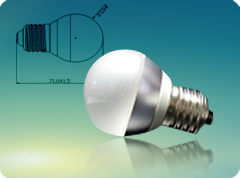Thermal dissipation has been a serious issue with the invention of high power LED lighting. Constrained by the internal and external quantum efficiencies, a non-radiative process in active layer converts most of the electrical power to heat. Generated heat will increase the junction temperature significantly. Higher temperature may damage the PN junction, lower luminous efficiency, increase forward voltage, cause wavelength shift, reduce lifetime, and affect quantum efficiency of phosphor. Therefore, rapidly removing heat from the chip and keeping the junction temperature below a certain limit are crucial for the maintenance of LED lighting performance.
There are two paths for heat dissipation. One is conducting heat through upper phosphors and encapsulants, the other is conducting heat through chip attached materials. Since all of the heat must be conducted through the materials. Considering the super heat flux density of chips, these materials should not only present high thermal conduction, but also rapidly spread the heat to areas with effective configurations. Applying high conductive metal as the heat slug is the first solution of high power LED packaging. Then, the chip-on-ceramic board technique is proposed to minimize the size of LED lighting. Other techniques proposed for the solution of high power LED packaging include directed bonded cooper, metal core printed circuit board, and composite material.
Product List
- LED Light Bulb
- LED Tube Light
- LED Spot Light
- LED Strip
- LED Down Lights
- LED Bay Lights
- LED Panel Light
- LED Module
- COB LED Light
- Rechargeable LED Lights
- LED Sensor Light
- LED Christmas Lights
- Power Supply
- LED Flood Light
Latest News
- The LED Tube Light Fixture - Answer to Those High Bills
- Installing LED Spotlight Bulb Outdoor to Get Benefits Now
- LED Striplight for Cars-Upgrade the Look of Your Vehicle
- The Best LED Light Bulb Review For Customers
- Four Factors of LED Light Technology Development Trend
- Buy Dimmable LED Light Bulbs Save Your Energy and Money
- The Growth of LED Light Industry India
- LED Streetlight Cost Saving Examination
Contact Us
(86) 372 5081976
sale@chineselight.com
FAQ





